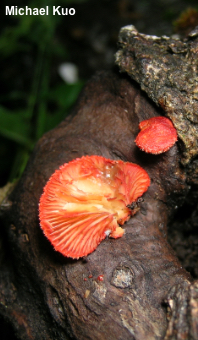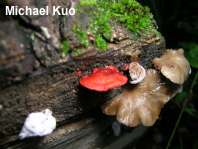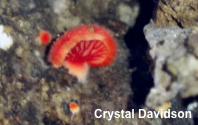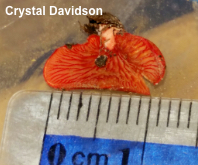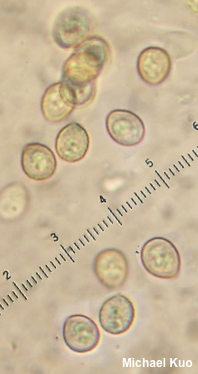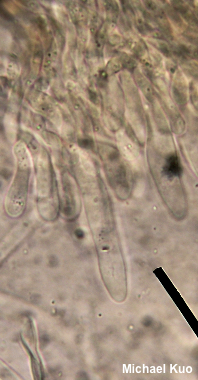| Major Groups > Gilled Mushrooms > Dark-Spored > Pleurotoid Mushrooms > Crepidotus > Crepidotus cinnabarinus |

|
Crepidotus cinnabarinus [ Basidiomycota > Agaricales > Inocybaceae > Crepidotus . . . ] by Michael Kuo Like other species of Crepidotus, Crepidotus cinnabarinus features a brown spore print and a small, fan-shaped fruiting body—but unlike other species in the genus, it is brightly colored, making it fairly unmistakeable. The little mushrooms are brightly colored and fairly easy to see, but they are particularly tiny, maxing out at about 2 cm across. Both of the collections featured here (mine, from Michigan 2008, and one sent to me from Ohio by Crystal Davidson in 2018) were growing on very old deadwood, alongside putrified, decaying remains of another, larger pleurotoid mushroom (possibly another species of Crepidotus). The same phenomenon can be observed in a number of online photos of Crepidotus cinnabarinus, raising the possibility that some sort of parasitism or mutualism is occurring. Crepidotus cinnabarinus was originally described from Michigan, but its range has since been extended into Canada and southward into Mexico—and it has apparently made a fairly recent debut in Europe, as well. Thanks to Crystal Davidson for collecting, documenting, and preserving Crepidotus cinnabarinus for study; her collection is deposited in The Herbarium of Michael Kuo. Description: Ecology: Probably saprobic, but see the comments above; growing alone, scattered, or gregariously on the well decayed deadwood of hardwoods (especially basswood and aspens); fairly rare; widely distributed east of the Great Plains, from southern Canada to Mexico. The illustrated and described collections are from Michigan and Ohio. Cap: 2–18 mm across; semicircular, shell-shaped, or fan-shaped; finely fuzzy when fresh, becoming minutely pitted or more or less bald; dry; bright orangish red. Gills: Close or nearly distant; when young yellow with red edges or red overall; becoming dull brown with maturity. Stem: Absent, but a pale, lateral pseudostem is occasionally present. Flesh: Soft; thin; whitish to yellowish; unchanging when sliced. Odor and Taste: not distinctive. Chemical Reactions: KOH on cap surface slowly dark red. Spore Print: Brown. Microscopic Features: Spores 5–7 x 4–5 µm; broadly ellipsoid; finely roughened, but often appearing more or less smooth; hyaline in KOH; faintly to moderately dextrinoid. Basidia 4-sterigmate. Pleurocystidia not found. Cheilocystidia 50–60 x 6–6 µm; cylindric with rounded or subfusiform apices; flexuous; smooth; thin-walled; hyaline in KOH. Pileipellis a cutis; elements 2.5–5 µm wide, hyaline to pinkish orange in KOH, smooth. Clamp connections not found. REFERENCES: Peck, 1895. (Saccardo, 1899; Kauffman, 1918; Hesler & Smith, 1965; Luther & Redhead, 1981; Schalkwijk-Barendsen, 1991; Bandala & Montoya, 2000; McNeil, 2006; Kuo & Methven, 2010.) Herb. Kuo 09140801, 09161801. This site contains no information about the edibility or toxicity of mushrooms. |
© MushroomExpert.Com |
|
Cite this page as: Kuo, M. (2019, September). Crepidotus cinnabarinus. Retrieved from the MushroomExpert.Com Web site: http://www.mushroomexpert.com/crepidotus_cinnabarinus.html |
